After working on a number of new experiments early last week, on Thursday I spent most of my day working on cargo ops, mainly unpacking those gigantic bags that, as I mentioned earlier, we moved out of Dragon and temporarily stowed on Station while we unloaded urgent science.
You can never tell how long it will take to unpack a bag just by looking at the number of items it contains: even a few items can take a long time if the stowage locations are challenging. Let’s say, for example, that you have to rotate a rack to get to a stowage compartment that is located in the aft, curved part of the rack, the one that lies against the cylindrical hull of a module.
Rotating a rack in itself is not complicated, but often you have to move stuff out of the way of the rotation path: bags, cables, computers, cameras… and then put them back once you are done. Imagine rotating part of your wall at home to access a secret room in the back, except that you have plenty of stuff attached to the wall and to the ceiling!
Anyway, I owe you some words about the Nematode muscle experiment I worked on last week. First of all, please welcome back to the International Space Station our good old friends, the C.Elegans. Yes, thanks to their very well understood genetic makeup, these tiny worms are a very popular model organism, on and off the planet! Remember the Epigenetics experiment?
But let’s talk about this new experiment. As the name implies, it’s about muscle, and specifically muscle atrophy. It’s very clear by now that muscle atrophy is a consequence of spaceflight and it makes sense intuitively, but we don’t understand yet the basic biological mechanisms that lead to loss of muscle mass.
 See, we astronauts can counteract these negative effects by working out every day, because we are healthy. But what about sick people who are bed-ridden? Understanding the molecular mechanisms that cause muscle atrophy could be useful in finding ways to help them!
See, we astronauts can counteract these negative effects by working out every day, because we are healthy. But what about sick people who are bed-ridden? Understanding the molecular mechanisms that cause muscle atrophy could be useful in finding ways to help them!
Like so often in science, Nematode muscle is a follow-up experiment that builds on previous space research.
The team has already established a few years ago that if you fly C. Elegans to space they will have a reduced protein concentration in muscles and in the cytoskeleton (the “bones” of the cell). Also, quite interestingly, their metabolism will shift to an energy-saving mode. Now the question is: how do cells receive signals that induce those changes? How is the message conveyed? And, for those of you who are into biology, I’ll add that the insulin/IGF-1 signaling, in particular, will be investigated, so see if it can account alone for the metabolic changes. Or maybe, on the contrary, there’s more out there to find out about how cells “get the message”. Fascinating stuff!
The weekend, by the way, was pretty quiet up here. We even got most of Friday off to recover from working two weeks straight, which was nice. Terry and I are heading home in just a couple of weeks and there’s still a lot to be done to wrap up our Space Station life and get things ready to welcome the next inhabitants of our outpost in space.
P.S. Many thanks to +Dmitry Meshkov who is now translating this logbook in Russian, starting with the most recent ones.
And of course, renewed thanks to the Italian, French, Spanish and German translators of #SamLogbook for their continuing amazing work. You guys rock!
Futura mission website (Italian): Avamposto42
avamposto42.esa.int
(Trad IT) Traduzione in italiano a cura di +AstronautiNEWS
qui: https://www.astronautinews.it/tag/logbook
(Trad FR) Traduction en français par +Anne Cpamoa ici: https://spacetux.org/cpamoa/category/traductions/logbook-samantha
(Trad ES) Tradducción en español por
+Carlos Lallana Borobio
https://laesteladegagarin.blogspot.com.es/search/label/SamLogBook
(Trad DE) Deutsch von https://www.logbuch-iss.de
(Trad Russo) +Dmitry Meshkov https://samlogbook-ru.livejournal.com
29/04/2015




